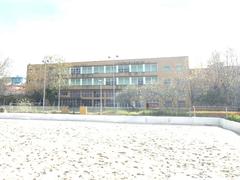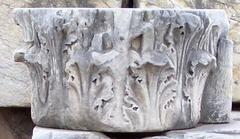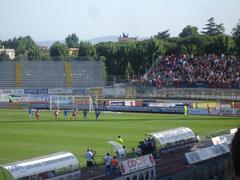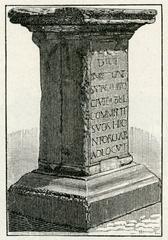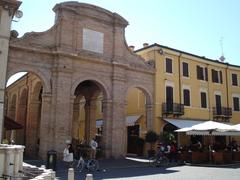
Summer Colony of the Adriatic Electricity Company, Rimini, Italy: Visiting Hours, Tickets, and Historical Significance
Date: 14/06/2025
Introduction
Set against the scenic backdrop of Italy’s Adriatic coast, the Summer Colony of the Adriatic Electricity Company (Colonia Estiva della Società Adriatica di Elettricità, or S.A.E.) in Rimini stands as a remarkable testament to the intersection of social progress, architectural innovation, and coastal leisure. Established in the early 20th century by the Società Adriatica di Elettricità (SADE), the colony was part of a pioneering welfare initiative that provided children and workers from urban centers with access to the restorative benefits of the seaside. Today, the site is a striking example of Rationalist and Modernist architecture and has become a vibrant cultural hub, drawing visitors interested in history, design, and Rimini’s unique coastal lifestyle (Wikipedia - Rimini; Visit Rimini; ICCROM Handbook).
This comprehensive guide explores the origins, architecture, social relevance, and practical visitor information for the Summer Colony, including hours, tickets, accessibility, nearby attractions, and tips to make the most of your visit.
Table of Contents
- Early 20th-Century Context: Electrification and Social Change
- The Birth of the Summer Colony: Vision and Development
- Construction, Early Years, and Social Impact
- Fascist Era Expansion
- Postwar Transformation and Current Legacy
- Visiting Information: Location, Hours, and Tickets
- Guided Tours, Accessibility, and Best Times to Visit
- Nearby Attractions and Cultural Synergy
- Visitor Facilities and Practical Tips
- Frequently Asked Questions (FAQ)
- Conclusion and Recommendations
- References and Official Links
Early 20th-Century Context: Electrification and Social Change
At the turn of the 20th century, Italy’s Adriatic coast was rapidly modernizing, with the founding of the Società Adriatica di Elettricità (SADE) in 1905 acting as a catalyst for regional development. The arrival of electricity revolutionized Rimini—already known for its Roman heritage and as a nascent seaside resort—enabling the creation of new infrastructure, hotels, and leisure facilities. These advancements set the stage for social welfare projects like summer colonies, aimed at improving public health and social cohesion (nl.wikiital.com; en.wikipedia.org).
The Birth of the Summer Colony: Vision and Development
The concept of a “summer colony” (colonia estiva) emerged from early 20th-century European social reform movements, focusing on children’s health and well-being. In Italy, these initiatives gained further traction during the Fascist era, with an emphasis on physical fitness, collective identity, and welfare. SADE established several colonies along the Adriatic, blending philanthropy and modern architectural innovation. The Rimini site became a flagship example, featuring campus-like layouts with dormitories, refectories, and recreational spaces, all built in the Rationalist style characterized by clean lines, abundant light, and strong ocean breezes (ICCROM Handbook).
Construction, Early Years, and Social Impact
Rimini’s long, sandy beaches, mild climate, and established health resort reputation made it the ideal colony location. By the early 20th century, thanks to electrification, Rimini could support large-scale facilities. The colony offered hundreds of children nutritious meals, medical care, and supervised recreation, structured to foster discipline and well-being. It quickly became part of Rimini’s social fabric, offering opportunities to families otherwise unable to afford seaside holidays and serving as a model for similar initiatives across Italy (alps2coast.com).
Fascist Era Expansion
Between 1922 and 1943, the Fascist government expanded summer colonies as instruments of state policy, using them to instill discipline and patriotism in the youth. The colony in Rimini was further developed and integrated into a nationwide network, with its architecture reflecting the monumental Rationalist style favored by the regime (en.wikipedia.org).
Postwar Transformation and Current Legacy
World War II devastated Rimini, with extensive bombing damaging much of the city, including the colony (alps2coast.com). Postwar reconstruction modernized the colony and broadened its mission to include education and cultural enrichment. Today, as Rimini welcomes millions of tourists annually, the colony’s preserved architecture remains a symbol of innovation and social progress, often repurposed for cultural events, exhibitions, and community activities (Italia.it).
Visiting Information: Location, Hours, and Tickets
Location and Access
The Summer Colony is ideally situated along Rimini’s seafront, easily accessible from the city center and well-connected by train, bus, and bicycle. The Rimini train station is a short distance away, and Federico Fellini International Airport serves both domestic and European flights (Savoring Italy).
Opening Hours
- General Opening: 9:00 AM – 6:00 PM daily (April–October; closed Mondays and public holidays)
- Off-Peak Season: Confirm specific hours with the official Rimini tourism website or local visitor centers.
Tickets
- Public Areas: Free entry
- Guided Tours/Special Exhibitions: Typically €5–€12; purchase online or at visitor centers.
Guided Tours
- Available during festivals and by advance booking, focusing on architecture, history, and cultural significance.
- Advance booking recommended, especially during peak seasons.
Guided Tours, Accessibility, and Best Times to Visit
Accessibility
- Most areas are accessible for visitors with mobility challenges; ramps and elevators are available where possible.
- Some historic structures may have limited access; inquire with the Rimini Visitor Center for details.
Best Times to Visit
- Spring & Early Autumn (April–June, September–October): Mild weather, fewer crowds.
- Summer: Vibrant festivals and events but busier.
Nearby Attractions and Cultural Synergy
The colony sits among Rimini’s rich tapestry of historical and cultural sites:
- Ponte di Tiberio: Iconic 1st-century Roman bridge (Visit Rimini).
- Arco d’Augusto: The oldest surviving Roman triumphal arch.
- Tempio Malatestiano: Rimini’s Renaissance cathedral.
- Borgo San Giuliano: Colorful district famed for Fellini-inspired murals and cuisine.
Proximity to Rimini’s 15-kilometer beach allows visitors to combine historical exploration with seaside leisure and family-friendly beach clubs (Full Suitcase).
Visitor Facilities and Practical Tips
- Transport: Walk, bike, or use Rimini’s public buses and Metromare shuttle (Start Romagna).
- Accessibility: Step-free paths and accessible facilities are standard; tourist offices provide multilingual support.
- Health/Safety: Rimini is safe, with pharmacies and clinics throughout the city.
- Dining & Accommodation: Options range from seafront hotels to family-run trattorias serving local Emilia-Romagna specialties (Savoring Italy).
- Special Events: The “La Notte Rosa” summer festival and other local events often feature programming at the colony (Emilia Romagna Turismo).
Frequently Asked Questions (FAQ)
What are the visiting hours?
9:00 AM–6:00 PM daily (April–October). Check official sources for seasonal updates.
Is there an entrance fee?
Public spaces are free; special exhibitions or guided tours may require a ticket (€5–€12).
Are guided tours available?
Yes, especially during festivals and peak season. Book in advance for best availability.
Is the site accessible?
Most areas are wheelchair-friendly; check with the visitor center for specific needs.
How do I reach the colony?
On foot, by bike, by public transport, or by car. The location is central and well-signposted.
Are there special events?
Yes. Check the city’s event calendar for exhibitions, festivals, and workshops at the colony.
Conclusion and Recommendations
The Summer Colony of the Adriatic Electricity Company in Rimini is more than a historical monument—it is a living symbol of Italy’s commitment to social welfare, architectural innovation, and community. Visitors can appreciate its Rationalist design, explore its landscaped grounds, and engage with diverse cultural programming. Well-integrated into Rimini’s vibrant tourism scene, the colony offers a family-friendly, accessible, and enriching experience, complete with nearby historical sites, lively festivals, and the welcoming Adriatic coastline.
To plan your visit, consult the official Rimini tourism portal, book guided tours in advance, and explore related attractions for a complete Rimini experience. For enhanced guidance, download the Audiala app and follow local social media channels for real-time updates on events and tips.
References and Official Links
- Wikipedia - Rimini
- Società Adriatica di Elettricità - nl.wikiital.com
- Beaches, History and Art: What to See and Do in Rimini - alps2coast.com
- Rimini Official Tourism Website
- Exploring Rimini’s Roman Monuments - Visit Rimini
- ICCROM Handbook on Modern Heritage Preservation
- Sport Science ECSS Rimini 2025
- Savoring Italy: Rimini Travel Guide
- Travel + Leisure: Rimini Italy Guide
- Emilia Romagna Turismo: Rimini Events
- Italia.it: Guide History Facts Rimini
- Full Suitcase: Rimini Italy Travel
- PlanetWare: Tourist Attractions Rimini
- Nomads Travel Guide: One Day in Rimini
- Lonely Planet: Rimini Travel Guide
Images to accompany this guide:
- The Summer Colony’s Rationalist facade (alt: “Summer Colony of the Adriatic Electricity Company in Rimini - Rationalist architecture”)
- Map of Rimini showing the colony’s location
- Photos from “La Notte Rosa” festival and Rimini’s historic center
Enhance your visit with virtual tours and interactive maps, available on the official Rimini tourism website.
